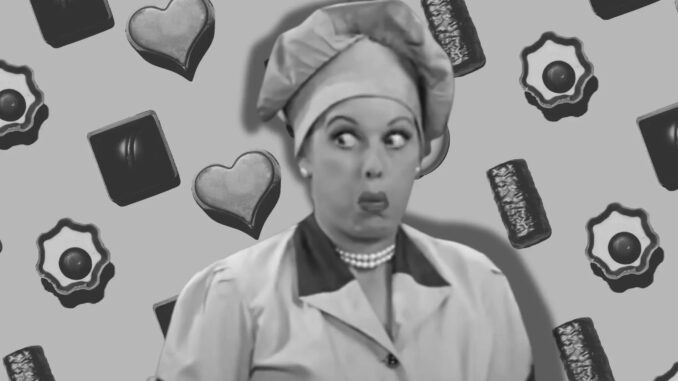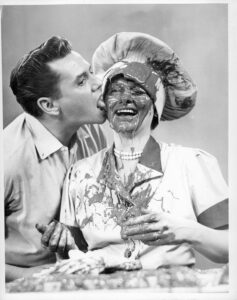
There are few scenes in television history as iconic as the I Love Lucy chocolate factory episode. Even if you’ve never seen a single episode of I Love Lucy, chances are you’ve seen clips of Lucy and her friend Ethel working frantically on a conveyor belt filled with chocolates, trying (and failing) to keep up. This episode, officially titled “Job Switching,” has become a classic moment of TV comedy and a cultural reference for slapstick humor at its best. But what’s the real story behind this unforgettable scene? Let’s dive into the backstory, filming secrets, and legacy of this unforgettable moment.
The Creation of the Chocolate Factory Scene
The Birth of I Love Lucy’s Most Beloved Scene
The chocolate factory episode aired on September 15, 1952, in the show’s second season. The premise was simple yet brilliant: Lucy and Ethel decide to switch roles with their husbands, Ricky and Fred, in a test to see who can handle each other’s responsibilities better. While Ricky and Fred try their hand at housework, Lucy and Ethel take on jobs outside the home, landing in a candy factory.
Writers’ Inspiration for a Timeless Comedy Bit
The scene of Lucy and Ethel in a chocolate factory was inspired by the real pressures many women faced when they entered the workforce in the 1950s. The comedic genius of the show’s writers, including Jess Oppenheimer, Madelyn Pugh, and Bob Carroll Jr., turned a simple scenario into a hilarious sequence, capturing the chaos that unfolds when people are placed outside their comfort zones.

A Moment of Female Empowerment with a Twist of Humor
At a time when television didn’t frequently showcase women working in challenging, traditionally male-dominated jobs, this scene resonated with audiences. It allowed Lucille Ball to playfully explore the role of a working woman in the ’50s, all while making audiences laugh uncontrollably.
Behind the Scenes: How the Scene Came to Life
Preparing for the Chocolate Conveyor Belt
Bringing the chocolate factory scene to life wasn’t as easy as it looked. To capture the hilarious chaos, the cast and crew had to work hard to make it feel authentic yet exaggerated. Lucille Ball, known for her dedication to comedy, was eager to make the scene as funny as possible.
Lucille Ball’s Reluctance to Eat Chocolates
Although Lucy appeared to devour chocolates effortlessly, Ball wasn’t too thrilled about it. She initially hesitated at the idea of stuffing herself with candy for the scene. However, her commitment to comedy prevailed, and she dove into the role, eating and stuffing chocolates with comedic flair that only she could deliver.
Real Candy, Real Challenges
Interestingly, the candies on set were real. The scene required Lucille Ball and Vivian Vance to handle, eat, and hide chocolates as the conveyor belt sped up, creating a real challenge as they tried to keep up. The constant retakes and physical comedy were exhausting for the actors, but their efforts made the scene even more convincing.
The Technical Magic Behind the Scene
Special Effects on a Budget
Back in the 1950s, TV shows didn’t have the luxury of advanced special effects, so I Love Lucy’s team had to rely on practical effects. The conveyor belt, which had to operate at various speeds to heighten the comedic effect, required a level of control that kept the crew on their toes.
The Conveyor Belt Malfunctions
At one point during filming, the conveyor belt malfunctioned, accelerating faster than intended. Rather than stopping the scene, Ball and Vance improvised, creating a sequence that would turn out to be one of the funniest moments on television.
Audience Reactions and Cultural Impact
Why This Scene Became an Instant Hit
When the chocolate factory episode aired, viewers were in stitches. The episode’s simple setup, relatable concept, and physical humor resonated widely. Audiences loved seeing Lucy’s and Ethel’s increasingly frantic attempts to hide, eat, and stow away chocolates, a sequence that has since been quoted, reenacted, and remembered for generations.
A Lesson in Timing and Physical Comedy
Ball’s impeccable timing and natural flair for physical comedy were on full display in the chocolate factory scene. Her expressions and movements perfectly captured the character’s desperation, making it easy for audiences to empathize with her—and laugh at her at the same time.

The Chocolate Factory’s Legacy in Television
How I Love Lucy Set a New Standard for TV Comedy
With the success of “Job Switching,” I Love Lucy established a benchmark for physical comedy in television. This episode demonstrated that comedy didn’t have to rely solely on dialogue; sometimes, the funniest moments came from visual gags and perfect timing.
Imitated But Never Duplicated
Since the 1950s, many TV shows have attempted to replicate I Love Lucy’s style of humor, but none have quite matched the magic of the original. The chocolate factory scene remains a high point in the show’s legacy and an enduring lesson in comedic acting.
Fun Facts About the Chocolate Factory Episode
1. It Wasn’t Originally Supposed to Be a “Messy” Scene
Initially, the episode didn’t call for Lucy and Ethel to be overwhelmed by chocolates. It was Lucille Ball’s improvisational skills that transformed the scene into a classic slapstick moment.
2. Lucille Ball’s Physical Comedy Skills Were Legendary
Despite her glamorous public image, Ball was a master of physical comedy. She insisted on doing her own stunts, which added an authenticity to the chocolate scene that endeared her to viewers.
3. Lucille Ball and Vivian Vance’s Real-Life Friendship Helped
The strong bond between Ball and Vance added depth to their on-screen partnership. The genuine chemistry between Lucy and Ethel was a product of their real-life friendship, allowing them to play off each other in the scene.
4. The Episode Remains Popular in Syndication
Decades later, the chocolate factory episode continues to be one of the most-watched I Love Lucy episodes in syndication, proving its timeless appeal.
5. The Scene Inspired Future Generations of Female Comedians
From Carol Burnett to Tina Fey, many female comedians have cited Lucille Ball as an inspiration. The chocolate factory scene in particular has been highlighted as a masterclass in comedic timing.
Why “Job Switching” Still Resonates Today
Relatable Humor That Transcends Generations
Part of what makes the chocolate factory scene so beloved is its timeless relatability. Who hasn’t felt overwhelmed by a task that gets out of control? Whether you’re juggling deadlines, dealing with life’s “conveyor belts,” or simply facing the chaos of modern life, Lucy and Ethel’s hilarious struggles still hit home.
Breaking Boundaries for Women in Comedy
Lucy’s ability to make audiences laugh while tackling subjects like gender roles and the challenges of work-life balance was groundbreaking for its time. Her influence is still seen in today’s comedy landscape, where more and more women are taking on roles that blend humor with real-life issues.
Conclusion
The chocolate factory episode of I Love Lucy has earned its place in television history for good reason. With perfect comedic timing, physical humor, and relatable themes, it encapsulates everything that made I Love Lucy a pioneering show. Lucille Ball’s dedication to her craft, along with the chemistry between her and Vivian Vance, created a piece of television that is not only funny but also meaningful. The chocolate factory scene isn’t just a comedy skit—it’s a celebration of friendship, resilience, and the hilarious messiness of life.
FAQs
Q: Why is the chocolate factory scene so iconic?
A: Its relatable humor, perfect comedic timing, and physical comedy make it a timeless classic in TV history.
Q: Did Lucille Ball eat real chocolates during the scene?
A: Yes, the chocolates were real, adding authenticity to the scene and making it even funnier.
Q: How did Lucille Ball feel about filming this scene?
A: While initially reluctant to eat so much chocolate, Ball’s dedication to comedy helped her embrace the role and create a classic moment.
Q: What episode features the chocolate factory scene?
A: The episode is titled “Job Switching” and is the first episode of I Love Lucy’s second season.
Q: Why is I Love Lucy still popular today?
A: The show’s humor, relatable themes, and groundbreaking role in television make it a favorite across generations.
